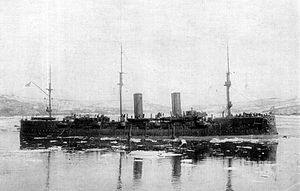Russian cruiser Rurik (1892)
The Imperial Russian Navy, by the end of the 19th century required a cruiser capable of undertaking long cruises into foreign waters for the purpose of destroying commercial vessels, especially if war was to occur between Russia and the United Kingdom.
Shestakov's successor, Chikhachev, had excellent relations with the MTK board, and the Baltic Works design was quickly rejected.
The MTK design which followed was a 10,000-ton vessel with a 10 inch belt and with an operational speed and range of 18 knots (33 km/h) and 10,000 nautical miles (20,000 km) respectively.
They were met by a squadron of Japanese warships commanded by Vice Admiral Kamimura Hikonojō in the Tsushima Strait between Korea and Japan, which resulted in the Battle off Ulsan.
Her speed was decreased, splitting it from the rest of the Russian ships, further exposing her to Japanese fire, and her steering jammed to port.
The Russian Admiral Karl Jessen attempted to provide cover for the ship, but was pushed back by the Japanese cruisers.
Despite her obsolete physical appearance, with the barque rigging and unprotected guns, Rurik performed surprisingly well at Ulsan.
The ship was quite possibly responsible for the escape of the other two Russian cruisers, though that can also be attributed to the Japanese indecisiveness at the battle.


